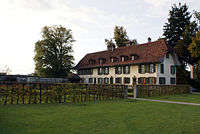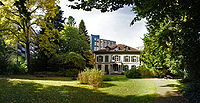
Bümpliz-Oberbottigen
Encyclopedia

As the most recently developed district of Bern, Bümpliz-Oberbottigen is an amalgamation of Bümpliz, a formerly independent suburban municipality, with rural hamlets such as Oberbottigen and Riedbach and modern highrise housing developments. The tower block
Tower block
A tower block, high-rise, apartment tower, office tower, apartment block, or block of flats, is a tall building or structure used as a residential and/or office building...
s of Gäbelbach, Tscharnergut and Stöckacker, a heritage from the 1960s and 70s, are a prominent part of Bethlehem's cityscape. The most recent quarter, Brünnen, was formally established in September 2008 as part of an ongoing major urban development programme.
Statistics
In 2006, the district had 31,343 inhabitants, 30% of which were foreigners, mostly South Eastern European nationals. This constitutes more than a third of Bern's entire foreign population. The apartment rents are the city's lowest, and 8.8% of the population received social welfare benefits in 2006, as compared to 4.6% in the city as a whole.With a surface area of 2,023 hectares, the district is the city's largest. It is a bedroom community, home to 25% of the city's population but only the location of 9% of the city's workplaces.
History
The area of Bümpliz has been a center of habitation since about the 5th century BC, as indicated by the presence of La TèneLa Tène culture
The La Tène culture was a European Iron Age culture named after the archaeological site of La Tène on the north side of Lake Neuchâtel in Switzerland, where a rich cache of artifacts was discovered by Hansli Kopp in 1857....
and Völkerwanderung burial grounds, as well as the remains of an extensive 1st century Roman villa
Roman villa
A Roman villa is a villa that was built or lived in during the Roman republic and the Roman Empire. A villa was originally a Roman country house built for the upper class...
at the site of today's St. Maurce church. In medieval times
Old Swiss Confederacy
The Old Swiss Confederacy was the precursor of modern-day Switzerland....
and under the Ancien Régime
Early Modern Switzerland
The early modern history of the Old Swiss Confederacy , lasting from formal independence in 1648 to the French invasion of 1798 came to be referred as Ancien Régime retrospectively, in post-Napoleonic Switzerland.The early modern period was characterized by an increasingly...
, the dominion of Bümpliz – recorded as Pimpenymgis in 1016 and Bimplitz in 1235 – changed hands from the Empire
Holy Roman Empire
The Holy Roman Empire was a realm that existed from 962 to 1806 in Central Europe.It was ruled by the Holy Roman Emperor. Its character changed during the Middle Ages and the Early Modern period, when the power of the emperor gradually weakened in favour of the princes...
to the lords of Bern and then numerous times among the patrician families of Bern, who built several palatial residences in Bümpliz.
The municipality
Municipalities of Switzerland
Communes , also known as municipalities, are the smallest government division in Switzerland, numbering 2,596 . While many have a population of a few hundred citizens, the largest cities such as Zürich or Geneva also have the legal status of municipalities...
of Bümpliz, founded 1798 in the course of the Napoleonic reforms
Switzerland in the Napoleonic era
During the French Revolutionary Wars, the revolutionary armies marched eastward, enveloping Switzerland in their battles against Austria. In 1798 Switzerland was completely overrun by the French and became the Helvetic Republic. The Helvetic Republic encountered severe economic and political problems...
, experienced a swift growth as a suburb of Bern after the 1860s. Financial difficulties forced it to agree to a merger with Bern in 1919. The new district continued to grow, in particular after 1945 with the construction of large-scale housing developments and satellite town
Satellite town
A satellite town or satellite city is a concept in urban planning that refers essentially to smaller metropolitan areas which are located somewhat near to, but are mostly independent of, larger metropolitan areas.-Characteristics:...
s (Tscharnergut 1958–67, Schwabgut 1965–71, Fellergut 1961–64, Gäbelbach 1965–68 and Kleefeld 1968–72).
Ambitious plans to build a high-rise satellite city for 150,000 inhabitants had to be shelved due to the recession brought about by the 1973 oil crisis
1973 oil crisis
The 1973 oil crisis started in October 1973, when the members of Organization of Arab Petroleum Exporting Countries or the OAPEC proclaimed an oil embargo. This was "in response to the U.S. decision to re-supply the Israeli military" during the Yom Kippur war. It lasted until March 1974. With the...
, and another plan failed in the 1990s due to the collapse of a bubble in the housing market. A much reduced development plan for the new Brünnen quarter was approved in a 1999 referendum. After lengthy court disputes, construction of the residential buildings and of the Westside shopping and leisure complex designed by Daniel Libeskind
Daniel Libeskind
Daniel Libeskind, is an American architect, artist, and set designer of Polish-Jewish descent. Libeskind founded Studio Daniel Libeskind in 1989 with his wife, Nina, and is its principal design architect...
commenced in 2005. The area is planned to be fully developed in 2018.
Buildings of note





Upper Burgundy
Upper Burgundy is the part of Burgundy east of the Jura mountains, that together with the western County of Burgundy from 868 formed the Kingdom of Upper Burgundy, encompassing both sides of the Jura mountains range...
royal court. A round tower, whose fundaments are visible in the cellar, was built by Peter II of Savoy in the 1260s. The current palace was built after 1488 by Rudolf von Erlach in the late medieval Romantic style and was partially adapted to the tastes of the Baroque
Baroque
The Baroque is a period and the style that used exaggerated motion and clear, easily interpreted detail to produce drama, tension, exuberance, and grandeur in sculpture, painting, literature, dance, and music...
by Franz Ludwig von Erlach in 1632. The moat was filled and the palace partially demolished in 1742; a modern extension was added in 1979-80.
Very close to the Old Palace, the Neues Schloss (New Palace) – a singular work in Bernese architectural history – was built in 1742 by Albrecht Türler for Daniel Tschiffeli. It housed a boys' school in the 19th century and is now the civil registry office of Bern; all civil marriage
Civil marriage
Civil marriage is marriage performed by a government official and not a religious organization.-History:Every country maintaining a population registry of its residents keeps track of marital status, and most countries believe that it is their responsibility to register married couples. Most...
s in the city are officiated in the palace's richly decorated great salon.
The reformed church of Bümpliz, formerly a Roman Catholic church dedicated to St. Maurice, was rebuilt in 1666 after a fire by Abraham Dünz. It received extensions by Karl Indermühle in 1915 and 1924 as well as by Karl Indermühle in 1952. Also in Bümpliz, the Feller country estate, a 1730 construction, was reshaped in the Classicist style in the 19th century, and is now embedded in the Fellergut highrise housing development. In Brünnen, the former lord's estate, a 1648 construction with 1765 extension by Niklaus Sprüngli, features painted wood carvings that are among Bern's best architectural sculptures from the Louis XV period.
In the rural landscape west of Bümpliz many significant works of traditional Bernese countryside architecture remain. The hamlet of Niederbottigen is among the best-preserved such settlements, including among others the Hochstudhaus, an 1675 farmhouse displaying exceptionally fine craftsmanship, and the Hans-Franz-Nägeli-Haus, a 17th century High Baroque country estate in the center of the settlement.
One of the area's first modern housing developments, the Morgenstrasse-Siedlung of 1943-44 in Bümpliz by Hermann Rüfenacht, is a testament to the Heimatstil-influenced wartime modern style in Switzerland. The Stapfenacker school, built 1930-31 by Karl Indermühle, is one of Switzerland's first schools in the Neues Bauen style.
The Tscharnergut tower blocks, built in Bethlehem in 1958-65 as a car-free satellite town for 5,000 inhabitants, were among the country's first highrise housing developments. In 1965-68, they were complemented by the Gäbelbach development, Bern's most architecturally prominent work of large-scale housebuilding. It consists of three immense tower blocks inspired by Le Corbusier
Le Corbusier
Charles-Édouard Jeanneret, better known as Le Corbusier , was a Swiss-born French architect, designer, urbanist, writer and painter, famous for being one of the pioneers of what now is called modern architecture. He was born in Switzerland and became a French citizen in 1930...
's Unités d'Habitation
Unité d'Habitation
The Unité d'Habitation is the name of a modernist residential housing design principle developed by Le Corbusier, with the collaboration of painter-architect Nadir Afonso...
linked by an axis of community buildings. Just south of Gäbelbach, the long-empty Brünnen field is currently being developed into an upmarket residential area. The new quarter's commercial and architectural centerpiece – the Westside complex by Daniel Libeskind
Daniel Libeskind
Daniel Libeskind, is an American architect, artist, and set designer of Polish-Jewish descent. Libeskind founded Studio Daniel Libeskind in 1989 with his wife, Nina, and is its principal design architect...
– was opened to the public on 8 October 2008.
External links
All links are in German.- District information on the city's website
- Websites of quarter associations:
- buempliz.ch
- bruennen.ch
- Local interest websites:
- Historical images of Bümpliz
- Local archives of Bümpliz

